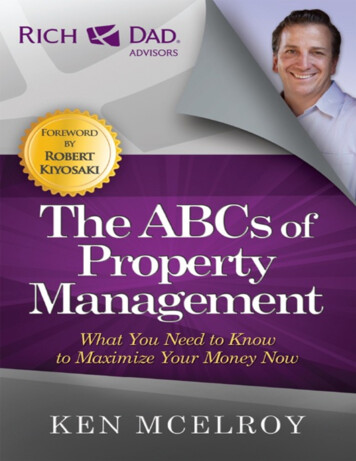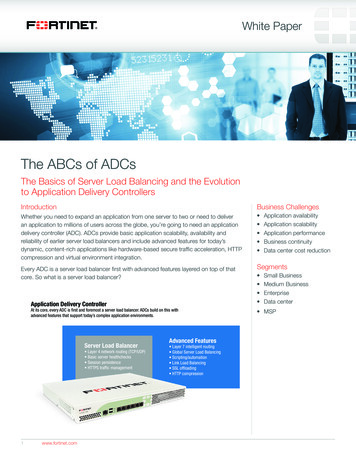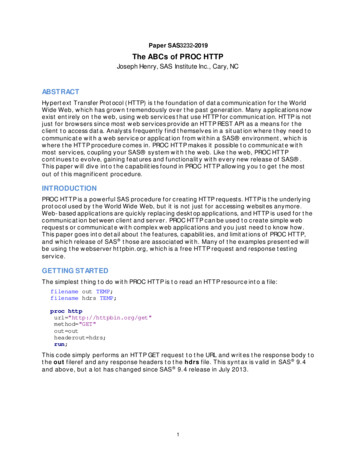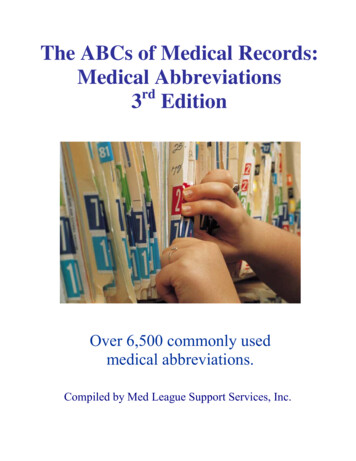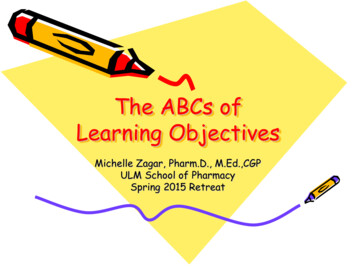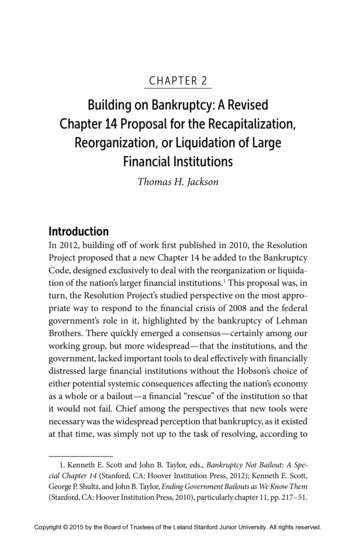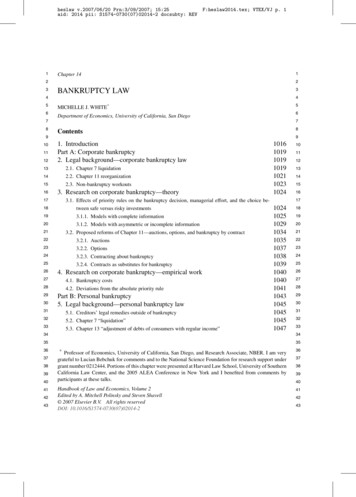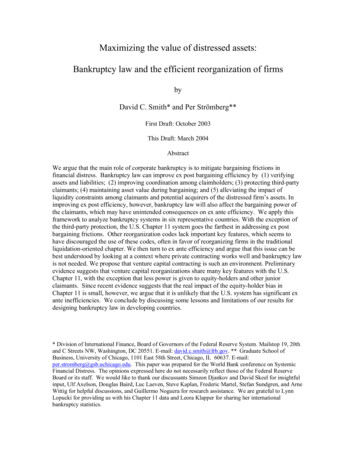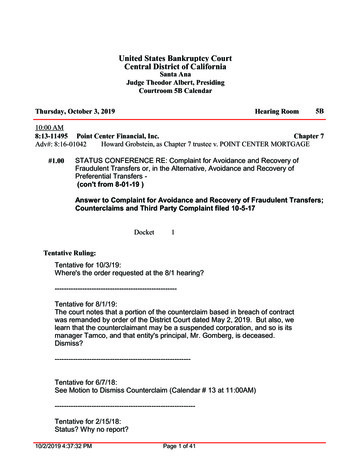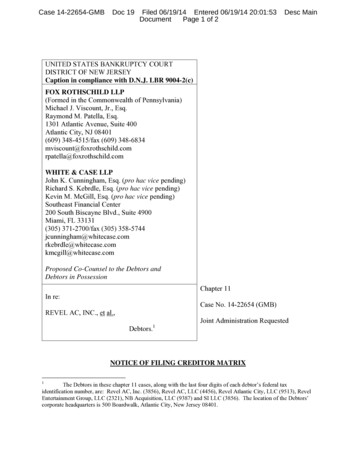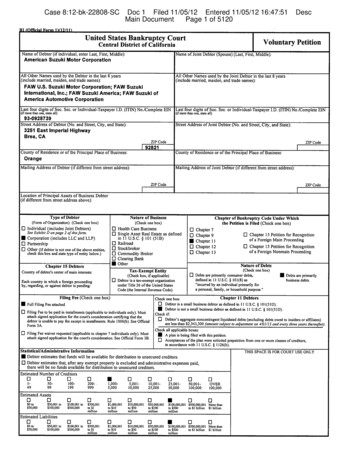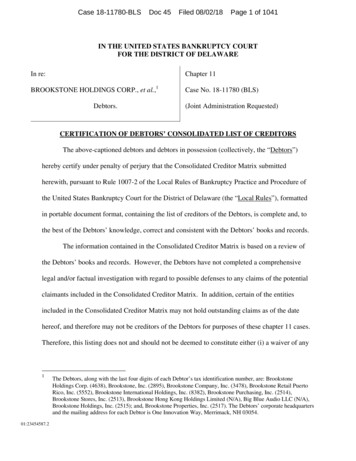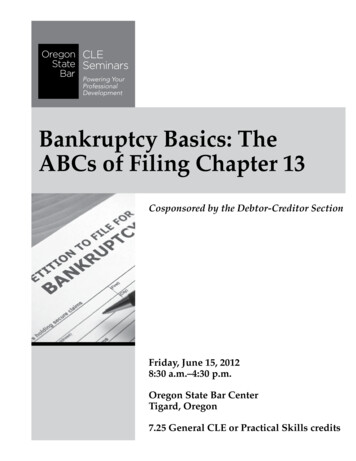
Transcription
Bankruptcy Basics: TheABCs of Filing Chapter 13Cosponsored by the Debtor-Creditor SectionFriday, June 15, 20128:30 a.m.–4:30 p.m.Oregon State Bar CenterTigard, Oregon7.25 General CLE or Practical Skills credits
Bankruptcy Basics: The ABCs of Filing Chapter 13Section PlannersThe Honorable Frank R. Alley, III, U.S. Bankruptcy Court, District of Oregon, EugeneAnn K. Chapman, Vanden Bos & Chapman LLP, PortlandChristopher N. Coyle, Vanden Bos & Chapman LLP, PortlandWayne Godare, Chapter 13 Trustee, PortlandOREGON STATE BAR Debtor-Creditor Section EXECUTIVE COMMITTEETara J. Schleicher, ChairSusan S. Ford, Chair-ElectPatrick W. Wade, Past ChairM. Caroline Cantrell, TreasurerDavid W. Hercher, SecretaryThe Honorable Frank R. AlleyE. Clarke BalcomChristopher N. CoyleWayne GodareKeith D. KarnesJustin D. LeonardHoward J. NewmanKaren M. OakesThomas M. OrrMilly WhatleyThe materials and forms in this manual are published by the Oregon State Bar exclusively for the use of attorneys.Neither the Oregon State Bar nor the contributors make either express or implied warranties in regard to the use of thematerials and/or forms. Each attorney must depend on his or her own knowledge of the law and expertise in the useor modification of these materials.Copyright 2012OREGON STATE BAR16037 SW Upper Boones Ferry RoadP.O. Box 231935Tigard, OR 97281-1935ii
Table of ContentsSchedule. . . . . . . . . . . . . . . . . . . . . . . . . . . . . . . . . . . . . . . . . . . . . . . . . . . . . . . . . . . . . . . . . . . . . . . . . . . . . vFaculty. . . . . . . . . . . . . . . . . . . . . . . . . . . . . . . . . . . . . . . . . . . . . . . . . . . . . . . . . . . . . . . . . . . . . . . . . . . . . . vii1.Chapter 13: Case Objectives and Applicable Law. . . . . . . . . . . . . . . . . . . . . . . . . . . . . . . . . . 1–i— Ann K. Chapman, Vanden Bos & Chapman LLP, Portland, Oregon— Christopher N. Coyle, Vanden Bos & Chapman LLP, Portland, Oregon2.Chapter 13: Drafting a Chapter 13 Plan from Theory to Practice—Dealing withTypical Scenarios. . . . . . . . . . . . . . . . . . . . . . . . . . . . . . . . . . . . . . . . . . . . . . . . . . . . . . . . . . . . . . . 2–i— Ann K. Chapman, Vanden Bos & Chapman LLP, Portland, Oregon— Christopher N. Coyle, Vanden Bos & Chapman LLP, Portland, Oregon3.Chapter 13 Trustee’s Office. . . . . . . . . . . . . . . . . . . . . . . . . . . . . . . . . . . . . . . . . . . . . . . . . . . . . . 3–i— Wayne Godare, Chapter 13 Trustee, Portland, Oregon4A.Chapter 13: The Creditor’s Perspective. . . . . . . . . . . . . . . . . . . . . . . . . . . . . . . . . . . . . . . . . . 4A–i— Stephen T. Tweet, Albert & Tweet LLP, Salem, Oregon4B.Confirmation and the Order Confirming Plan . . . . . . . . . . . . . . . . . . . . . . . . . . . . . . . . . . . . 4B–i— Christopher N. Coyle, Vanden Bos & Chapman LLP, Portland, Oregon5.Chapter 13: Confirmation to Completion. . . . . . . . . . . . . . . . . . . . . . . . . . . . . . . . . . . . . . . . . . 5–i— Ann K. Chapman, Vanden Bos & Chapman LLP, Portland, Oregon— Christopher N. Coyle, Vanden Bos & Chapman LLP, Portland, Oregon— Jordan S. Hantman, Office of the Chapter 13 Trustee, Portland, Oregon6.Chapter 13 Potpourri . . . . . . . . . . . . . . . . . . . . . . . . . . . . . . . . . . . . . . . . . . . . . . . . . . . . . . . . . . . 6–i— Christopher N. Coyle, Vanden Bos & Chapman LLP, Portland, Oregon— Jordan S. Hantman, Office of the Chapter 13 Trustee, Portland, Oregon7.Putting it All Together: Chapter 13 Hypotheticals. . . . . . . . . . . . . . . . . . . . . . . . . . . . . . . . . . 7–i— Douglas R. Ricks, Vanden Bos & Chapman LLP, Portland, Oregon— Ann K. Chapman, Vanden Bos & Chapman LLP, Portland, Oregon8.11 U.S.C. Chapter 13—Adjustment of Debts of an Individual with RegularIncome. . . . . . . . . . . . . . . . . . . . . . . . . . . . . . . . . . . . . . . . . . . . . . . . . . . . . . . . . . . . . . . . . . . . . . . . 8–iiii
iv
Schedule7:30 Registration8:30Chapter 13: Case Objectives and Applicable LawF Why debtors file Chapter 13F Legal framework and requirementsF Law regarding secured creditorsThe Honorable Frank R. Alley, III, U.S. Bankruptcy Court, District of Oregon, EugeneAnn K. Chapman, Vanden Bos & Chapman LLP, PortlandWayne Godare, Chapter 13 Trustee, Portland9:15Drafting a Chapter 13 Plan: From Theory to PracticeF Basic drafting requirementsF Trustee’s common drafting errorsF Drafting common scenariosThe Honorable Frank R. Alley, III, U.S. Bankruptcy Court, District of Oregon, EugeneAnn K. Chapman, Vanden Bos & Chapman LLP, PortlandWayne Godare, Chapter 13 Trustee, PortlandKeith D. Karnes, Cascade Pacific Lawyers, Salem10:15 Break10:30 Drafting a Chapter 13 Plan (Continued)11:00 Checking the Plan Against Confirmation RequirementsF Trustee’s plan analysisF Utilizing Trustee’s liquidation analysis and feasibility programsF Ensuring plan compliance with applicable commitment periodF Drafting complete Chapter 13 plansWayne Godare, Chapter 13 Trustee, PortlandJordan S. Hantman, Office of the Chapter 13 Trustee, Portland12:15 Lunch1:00Filing to ConfirmationF Defending the plan through confirmationF Objections to confirmationF ResponsesF Contested confirmation proceedingsF Lien avoidanceThe Honorable Frank R. Alley, III, U.S. Bankruptcy Court, District of Oregon, EugeneWayne Godare, Chapter 13 Trustee, PortlandKeith D. Karnes, Cascade Pacific Lawyers, SalemStephen T. Tweet, Albert & Tweet LLP, Salemv
SCHEDULE (Continued)2:30Break2:45Confirmation to CompletionF Treatment of tax refunds and income complianceF Post-confirmation eventsF Reviewing and objecting to claimsF Motions for reliefAnn K. Chapman, Vanden Bos & Chapman LLP, PortlandJordan S. Hantman, Office of the Chapter 13 Trustee, PortlandKeith D. Karnes, Cascade Pacific Lawyers, SalemStephen T. Tweet, Albert & Tweet LLP, Salem3:15Chapter 13 PotpourriF Tax concerns in bankruptcyF Hardship dischargeChristopher N. Coyle, Vanden Bos & Chapman LLP, PortlandJordan S. Hantman, Office of the Chapter 13 Trustee, Portland3:45Putting it All Together: Chapter 13 HypotheticalsThe Honorable Frank R. Alley, III, U.S. Bankruptcy Court, District of Oregon, EugeneAnn K. Chapman, Vanden Bos & Chapman LLP, PortlandWayne Godare, Chapter 13 Trustee, Portland4:30Adjournvi
FacultyThe Honorable Frank R. Alley, III, U.S. Bankruptcy Court, District of Oregon, Eugene. Prior to hisappointment in 1995, Judge Alley was a partner in the Medford, Oregon, firm of Fowler Alley &McNair, where his practice emphasized commercial litigation. He is a former member of the Boardof Governors of the Oregon State Bar and the Executive Committee of the bar’s Debtor-CreditorSection. He has taught Debtor/Creditor Relations and Bankruptcy at Willamette University Schoolof Law. He has served as a faculty member at the Northwest Bankruptcy Institute and in CLEpresentations for the Oregon State Bar Debtor-Creditor and Family Law Sections, the Conferenceof Chief Bankruptcy Judges of the Ninth Circuit, and the Bankruptcy Section of the State Bar ofMontana.Ann K. Chapman, Vanden Bos & Chapman LLP, Portland. Ms. Chapman practices in the areas ofbankruptcy law and commercial law. She is a member of the Credit Abuse Resistance EducationCommittee (C.A.R.E.), a member and past chair of the Oregon State Bar Debtor-Creditor Section,and a member of WOMBATS (Women Bankruptcy Attorneys). She has spoken on bankruptcyand practice management for the Oregon State Bar, the Multnomah Bar Association, the NationalBusiness Institute, and other professional organizations, and she has authored several articles onprofessionalism and other topics.Christopher N. Coyle, Vanden Bos & Chapman LLP, Portland. Mr. Coyle practices in the areas ofbankruptcy law, commercial litigation, and debtor/creditor issues. Prior to joining Vanden Bos &Chapman, Mr. Coyle was a solo practitioner practicing taxation and bankruptcy law. He is admitted to practice before the United States Tax Court. He is a member of the Oregon State Bar Taxationand Debtor-Creditor sections, C.A.R.E., and the Multnomah Bar Association.Wayne Godare, Chapter 13 Trustee, Portland. On June 1, 2010, Mr. Godare became the Chapter 13Bankruptcy Trustee for the District of Oregon, Portland Division. He was first admitted to theState Bar of Arizona in 1971, the Wyoming State Bar in 1983, and the Oregon State Bar in 1990. Mr.Godare has practiced bankruptcy law exclusively since joining the Oregon State Bar.Jordan S. Hantman, Office of the Chapter 13 Trustee, Portland. Mr. Hantman is a staff attorney forWayne Godare, Chapter 13 Trustee. Prior to joining the Trustee’s Office, he represented both debtors and creditors in consumer bankruptcy cases in Oregon.Keith D. Karnes, Cascade Pacific Lawyers, Salem. Mr. Karnes practices in the areas of bankruptcy,consumer law, foreclosure, and tax defense. He is past chair of the Oregon State Bar ConsumerLaw Section and a current member of the Oregon State Bar Consumer Law and Debtor-Creditorsections’ executive committees. He has written and lectured extensively on fair debt collection,foreclosure defense, bankruptcy, and credit reporting. Mr. Karnes is licensed to practice in Oregonand Washington.Stephen T. Tweet, Albert & Tweet LLP, Salem. Mr. Tweet’s practice emphasizes business law, bankruptcy, and creditors’ rights; he represents both debtors and creditors. Mr. Tweet is former secretary,treasurer, and chair of the Oregon State Bar Debtor-Creditor Section and a former adjunct professorof law teaching creditors’ rights at Willamette University.vii
viii
Chapter 1Chapter 13: Case Objectivesand Applicable LawAnn K. ChapmanVanden Bos & Chapman LLPPortland, OregonChristopher N. CoyleVanden Bos & Chapman LLPPortland, OregonTable of ContentsI.Introduction . . . . . . . . . . . . . . . . . . . . . . . . . . . . . . . . . . . . . . . . . . . . 1–1II.Reasons to Consider Chapter 13 . . . . . . . . . . . . . . . . . . . . . . . . . . . . . . . . . 1–1A Discharge with Dignity—A Debtor’s Desire to Repay the Creditors in aA.Controlled Environment . . . . . . . . . . . . . . . . . . . . . . . . . . . . . . . . . 1–2The Debtor Wants to Keep Nonexempt Assets . . . . . . . . . . . . . . . . . . . . . 1–2B.C.The Debtor Wants to Protect a Codebtor from Creditor Actions . . . . . . . . . . . 1–3D.The Forced “Redemption over Time” of Secured Collateral . . . . . . . . . . . . . 1–3E.The Debtor Wants to Keep Property by Curing a Prebankruptcy Default . . . . . . 1–4F.The Debtor Needs the Chapter 13 “Super Discharge” . . . . . . . . . . . . . . . . . 1–4The “Chapter 20” Case (Filing Chapter 13 on the Heels of Chapter 7) . . . . . . . . 1–5G.H.The Debtor Wants to Change Loan Terms . . . . . . . . . . . . . . . . . . . . . . . . 1–6I.The Debtor Needs to Stop Tax Collection and Pay Tax Debts over Time . . . . . . 1–7Consider Dissolving a Small Corporation and Assuming All Liabilities . . . . . . 1–7J.K.Stripping Wholly Unsecured Mortgages from Real Property . . . . . . . . . . . . . 1–7III.Legal Framework and Requirements . . . . . . . . . . . . . . . . . . . . . . . . . . . . . . 1–8A.Sources of Law . . . . . . . . . . . . . . . . . . . . . . . . . . . . . . . . . . . . . . . 1–8B.Speaking Greek: Bankruptcy Shorthand . . . . . . . . . . . . . . . . . . . . . . . . 1–9C.Conceptual Framework of Chapter 13: Composition, Pot, or ExtensionPlans . . . . . . . . . . . . . . . . . . . . . . . . . . . . . . . . . . . . . . . . . . . . 1–11D.Who May Be a Debtor . . . . . . . . . . . . . . . . . . . . . . . . . . . . . . . . . . 1–13Plan Drafting: Requirements and Optional Provisions . . . . . . . . . . . . . . . .1–14E.F.Confirmation Requirements . . . . . . . . . . . . . . . . . . . . . . . . . . . . . . .1–20IV.Law Regarding Secured Creditors . . . . . . . . . . . . . . . . . . . . . . . . . . . . . . . .1–23A.Collateral Value and Cram-Down . . . . . . . . . . . . . . . . . . . . . . . . . . . .1–23B.Interest Rates . . . . . . . . . . . . . . . . . . . . . . . . . . . . . . . . . . . . . . . .1–24C.Monthly Payments/Adequate Protection . . . . . . . . . . . . . . . . . . . . . . . 1–25Long-Term Debt . . . . . . . . . . . . . . . . . . . . . . . . . . . . . . . . . . . . . .1–26D.1–i
Chapter 1—Chapter 13: Case Objectives and Applicable Law1–ii
Chapter 1—Chapter 13: Case Objectives and Applicable LawI. IntroductionChapter 13, known as adjustment of debts of an individual withregular income, involves trustee administration of a debt repaymentplan by individuals pursuant to a confirmed plan. Plans run from 36to 60 months depending upon the circumstances. Only the debtor mayfile a plan in a Chapter 13 case. Contents of the plan are determined bythe Code and local rule. See 11 U.S.C. § 1322. There are mandatory localforms for the Chapter 13 plan. The plan must provide treatment to creditors that is at least the same as the creditors would receive in a Chapter7 case.Chapter 13 will normally be selected by an individual engaged inbusiness as a sole proprietor who: (1) wants to protect nonexempt property by paying the trustee its equivalent liquidation value in a Chapter7, (2) wishes to impose a payment schedule for repayment on the IRS orother taxing authorities (their consent is not required assuming certainlegal requirements are met), (3) needs the broader discharge provisionsavailable in Chapter 13 versus Chapter 7 (although limited under BAPCPA), (4) wishes to cure the arrearage on a secured claim (such as a trustdeed), (5) wishes to control the liquidation of certain property, or (6) hasthe ability or desire to repay out of income. The Bankruptcy Code oftenrequire debtors with income exceeding the state median income to file aChapter 13.Unlike Chapter 7, which requires the debtor to surrender his orher nonexempt assets to the trustee in return for an immediate dischargeunder Section 727, in Chapter 13 the debtor surrenders no assets to thetrustee.1 Instead, the Chapter 13 debtor keeps his or her assets and proposes a repayment plan for both secured and unsecured creditors over aperiod of time; the plan may last up to five years (and in some cases mustlast that long). This plan allows the Chapter 13 debtor to reorganize byallowing the debtor to structure payments to secured, priority, and unsecured creditors; in some cases, the debtor is given tremendous powerto dictate terms to creditors (though the Bankruptcy Code provides theouter bounds of what those terms may be). The discharge is entered atthe end of the Chapter 13 case after the debtor has completed all payments under the plan. 11 U.S.C. § 1328(a). However, there is a “stay” ofcollection against the debtor as soon as the case is pending. The scopeof the Chapter 13 discharge is still broader than the discharge awardedunder Section 727, although the amendments to the Bankruptcy Codein 2005 significantly reduced the breadth of what used to be the “super”discharge.II. Reasons to Consider Chapter 13Why would a debtor desire to file a Chapter 13 instead of a Chapter 7? Notwithstanding the appeal of an immediate discharge in Chapter7, debtor’s counsel should evaluate each individual’s circumstances andmake the appropriate recommendation regarding Chapter 7 or Chapter1All references to sections and chapters refer to Title 11, 11 U.S.C. § 101, et seq.1–1
Chapter 1—Chapter 13: Case Objectives and Applicable Law13. Creditors should also try to understand why a particular debtor filedChapter 13. For example, the debtor may have elected Chapter 13 instead of Chapter 7 because certain kinds of relief are available in Chapter 13 that is not available in Chapter 7. Once the creditor understandsthe reason the debtor selected Chapter 13, the creditor will be better ableto deal with the dynamics of the case and plan a response. The followingare some of the reasons individuals file Chapter 13 instead of Chapter 7.A.A Discharge with Dignity—A Debtor’s Desire to Repay theCreditors in a Controlled EnvironmentNotwithstanding the popularity of bankruptcy as a solution tofinancial problems, some debtors feel a duty or responsibility to theircreditors and want to try to pay back some of their debt. Theoretically,a debtor with 20 creditors could contact all 20 creditors and try to workout a repayment plan that combined a principal indebtedness write-offwith monthly payments outside bankruptcy. However, the likelihood ofgetting all 20 creditors to go along with the program is slim. Generally,it is more costly for the debtor to settle with his/her creditors outside ofbankruptcy. Chapter 13 enables those debtors who want to repay something to their creditors to make partial or full repayment. The debtorgets the benefit of the automatic stay—the bankruptcy shield—andupon successful completion of the plan, the debtor receives a Chapter13 discharge. The debtor can deal with all of his or her creditors in oneforum. The intransigent creditor who wasn’t willing to deal outside ofbankruptcy is left with no choice but to go along for the ride.B.The Debtor Wants to Keep Nonexempt AssetsIn Chapter 7, the debtor is obligated to surrender all nonexemptassets to the Chapter 7 trustee for liquidation. In Chapter 13, the debtorretains some or all assets (whether exempt or nonexempt) and proposesthe Chapter 13 plan. While the plan may include as one of its provisionsa sale of selected assets to fund the plan, the debtor is not required tosell any assets in Chapter 13. So long as the debtor meets the paymentrequirements of a confirmed Chapter 13 plan, the debtor should receivehis or her discharge—and the debtor will have kept all assets (both exempt and nonexempt).There is no unfairness in allowing the Chapter 13 debtor to keepsome or all assets, because one of the requirements for Chapter 13 planconfirmation is that the plan meet the “best interests of creditors test.” 11U.S.C. § 1325(a)(4). The “best interest of creditors test” means that holders of allowed unsecured claims in the Chapter 13 must receive throughthe Chapter 13 plan at least as much as they would have received if thedebtor’s assets were liquidated in Chapter 7. Thus, unsecured creditorsin Chapter 13 should not receive any less than they would receive inChapter 7. However, instead of unsecured creditors receiving a Chapter7 dividend after liquidation of nonexempt assets, the creditors receivetheir dividend during the life of the plan from the net disposable incomethat is paid by the debtor to the trustee to fund the plan.1–2
Chapter 1—Chapter 13: Case Objectives and Applicable LawC.The Debtor Wants to Protect a Codebtor from Creditor ActionsThe automatic stay of Section 362(a) protects the debtor no matterwhat type of bankruptcy is filed. However, Chapter 13 also includes acodebtor stay. 11 U.S.C. § 1301. Under the codebtor stay, a person who isobligated with a debtor on a consumer obligation is also protected fromcreditor action. It is common for many consumer debtors to have comakers or guarantors who may be liable with them to a creditor—usually arelative (i.e., a parent signing so a child can get a car loan). The Chapter13 codebtor stay stops the creditor from immediately going after thecodebtor. However, a creditor may request that the court terminate thecodebtor stay to allow a lawsuit against a nonbankrupt codebtor. Statutory grounds warranting relief from the codebtor stay exist when:“(1) as between the d
Godare has practiced bankruptcy law exclusively since joining the Oregon State Bar. Jordan S. hantman, Office of the Chapter 13 Trustee, Portland. Mr. Hantman is a staff attorney for Wayne Godare, Chapter 13 Trustee. Prior to joining the Trustee’s Office, he represented both debt-
